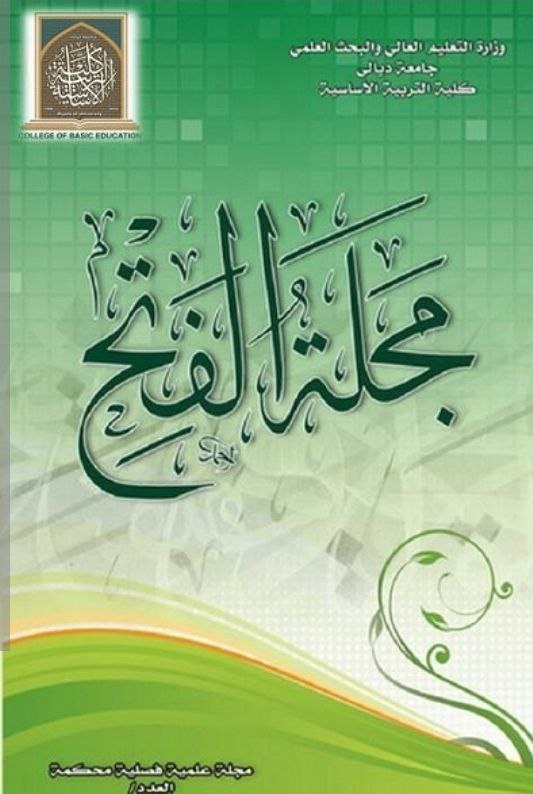The impact of learning the sequential method and repeating it randomly in mastering the skills of handling and shooting and saving the effort learned by handball for female students
Abstract
In the first section of the study, the two researchers dealt with the
scientific development taking place in the field of dynamic learning
that is going hand in hand with the multiplicity of methods and
styles followed in the learning process as well as tackling on of the
methods of measuring dynamic learning, that is, the re-learning
method, in addition to dealing with handball. The problem of the
paper lies in the issue that there is a clear cut deficiency in the
performance level in passing and shooting in handball which
resulting in the inability of female players to reach mastery level as
well as requiring lots of time and effort in learning. The paper aims
at setting trainings in the serial and random styles in order to master
the skills of passing and shooting in handball among first
intermediate female students.
Section two, then, is allotted to methods of dynamic learning (serial
and random), and saved effort (re-learning). The third section
comprised the study methodology along with its field procedures as
the researchers adopted the experimental method due to its
suitability to the problem and aims of the study. Sample of the study
is randomly selected of first intermediate female students
comprising of (30) female students. In section four, the researchers
focused on exposing, analyzing and discussing the study results that
are identified by the researchers in the pre-test, the first and second
post-tests as well as finding out saved effort. While section five is
including conclusions and recommendations of the study. The most
significant conclusions are: the re-learning approach provided saved
effort in learning the skills of passing and shooting in handball
among first intermediate female students.
References
أؽٔذ ػش٣ج٢ ػٞدح )1988)؛ ًشح اُ٤ذ ٝػ٘بطشٛب األعبع٤خ: )ُ٤ج٤ب، داس
أُطجٞػبد،(.
أُ٘ذالٝ١ هبعْ )ٝآخشٕٝ()1990 )؛ االخزجبساد ٝاُو٤بط ٝاُزوٞ٣ ْك٢ اُزشث٤خ
اُش٣بػ٤خ : ) أُٞطَ ، ٓطبثغ اُزؼِ٤ ْاُؼبُ٢. )
خِ٤ َإثشاٛ٤ ْعِ٤ٔبٕ أُؾذ٣ض٢(2013 )؛ اُزؼِْ اُؾشً٢(، عٞس٣ب، داس اُؼشاة
ُِذساعبد ٝاُ٘شش ٝاُزشعٔخ ،(.
خ٤ش اُذ٣ ٖػِ٢ اؽٔذ)1999 : )دُ٤ َاُجؾش اُؼِٔ٢ ، داس اُلٌش اُؼشث٢ ، اُوبٛشح .
ؿنبص١ طنبُؼ ٓؾٔنٞد)2011 )؛ ًنشح اُونذّ انا أُلنبٛ٤ ْانا اُزنذس٣ت ، ؽ1( : ػٔنبٕ ،
ٌٓزجخ أُغزٔغ اُؼشث٢.)،
كشاد عجبس عؼذ هللا )2015 )؛أعبع٤بد ك٢ اُزؼِْ اُؾشً٢ ، ؽ1(،ػٔبٕ ، داس
اُشػٞإ ُِ٘شش ٝاُزٞص٣غ،(.
هبعْ ُضاّ طجش ٝآخشٕٝ)2005 )؛ أعظ اُزؼِْ ٝاُزؼِ٤ٝ ْرطج٤وبرٚ ك٢ً شح اُوذّ
،)ثـذاد،(،.
ًٔ بٍ ػبسف ،عؼذ ٓؾغٖ)1989 )؛ ًشح اُ٤ذ :) ثـذاد ،ث٤ذ اُؾٌٔخ ،(.
ٓ بٛش ٓؾٔذ ػٞاد اُؼبٓش١(2014 )؛ كغ٤ُٞٞع٤خ اُزؼِْ اُؾشً٢،ؽ1(:اُ٘جشاط
ُِطجبػخ ٝاُزظٔ٤)،ْ
ٓ ؾٔذ رٞك٤ن اُُٞ٤ِ٢( 1998ً :)شح اُ٤ذ )اٌُٞ٣ذ، ششًخ ٓطبثغ اُغلّ(
ٓ ؾٔذ عبعْ اُ٤بعش١( 2010)؛ األعظ اُ٘ظش٣خ الخزجبساد اُزشث٤خ اُش٣بػ٤خ ،
ؽ2(:،داس اُؼ٤بء ُِطجبػخ ٝاُزظٔ٤، ْاُ٘غق األششف(
ٔٓ ذٝػ ػجذ أُ٘ؼْ ٝاؽٔذ ٓؾٔذ ٓجبسى )1992 )؛ع٤ٌُٞٞع٤ب اُزؼِْ ٝاٗٔبؽ اُزؼِْ
ٝرطج٤وبرٜب :)اٌُٞ٣ذ ،ٌٓزجخ اُللػ ،(
ٗ بٛذٙ ػجذ ص٣ذ ؛ رأص٤ش اُزذاخَ ك٢ أعبُ٤ت اُزٔش٣ ٖػِ٠ رؼِْ ٝرطٞس ٓغزٟٞ أداء
ٜٓبسر٢ اإلسعبٍ اُغبؽن ٝاُؼشة اُغبؽن ثبٌُشح اُطبئشح : )سعبُخ ٓبعغز٤ش – عبٓؼخ
ثـذاد ، ًِ٤خ اُزشث٤خ اُش٣بػ٤خ ، 2002)
ٗ ج٤ٓ َؾٔٞد شبًش)2007 )؛ ٓؼبُْ اُؾشًخ اُش٣بػ٤خ ٝاُ٘لغ٤خ ٝأُؼشك٤خ ، ؽ1 :
)ًِ٤خ اُزشث٤خ األعبع٤خ، عبٓؼخ د٣بُ٠. )،
ٝ ع٤ٓ ٚؾغٞة)2000)؛ اُزؼِْ ٝعُٞخ اُزذس٣ت،)ثـذاد ،ٝصاسح اُزشث٤خ، ٌٓزت اُؼبدٍ
ُطجبػخ اُل٘٤خ،(.
ٝ عبّ طلػ ػجذ اُؾغ٤ٝ ٖعبٓش٣ٞعق)2014)؛ اُزؼِْ اُؾشً٢ٝ رطج٤وبرٚ ك٢ اُزشث٤خ
اُجذٗ٤خ ٝاُش٣بػ٤خ،)داس اٌُزت اُؼِٔ٤خ ،ث٤شٝد(
٣ؼشة خ٤(ٕٞ2002 )؛ اُزؼِْ اُؾشً٢ ث٤ ٖأُجذأ ٝاُزطج٤ن ، )ثـذاد ، ٌٓزت اُظخشح
ُِطجبػخ ،(
Downloads
Published
How to Cite
Issue
Section
License
Copyright (c) 2023 مجلة الفتح للبحوث النفسية والتربوية

This work is licensed under a Creative Commons Attribution 4.0 International License.
حقوق النشر والترخيص
تطبق مجلة الفتح للبحوث التربوية والنفسية ترخيص CC BY (ترخيص Creative Commons Attribution 4.0 International). يسمح هذا الترخيص للمؤلفين بالاحتفاظ بملكية حقوق الطبع والنشر لأوراقهم. لكن هذا الترخيص يسمح لأي مستخدم بتنزيل المقالة وطباعتها واستخراجها وإعادة استخدامها وأرشفتها وتوزيعها ، طالما تم منح الائتمان المناسب للمؤلفين ومصدر العمل. يضمن الترخيص أن المقالة ستكون متاحة على نطاق واسع بقدر الإمكان وأن المقالة يمكن تضمينها في أي أرشيف علمي.
لمزيد من المعلومات، يرجى متابعة الرابط: https://creativecommons.org/licenses/by/4.0/.



